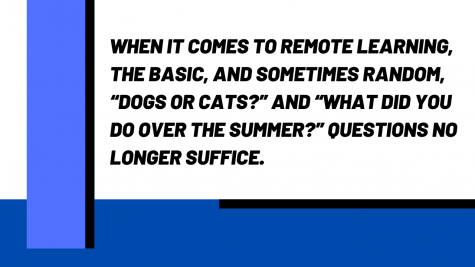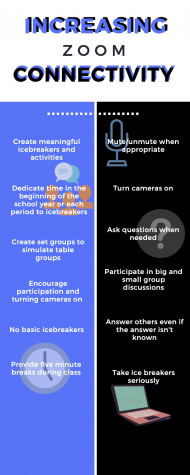Remote learning doesn’t have to hinder connectivity during classes
Simple actions while learning online can lead to a big difference
Faces on little enclosed rectangular boxes on our screens are an unorthodox way to go to school — to discuss ideas, to complete math problems, to do science experiments, and, the common thread between them all, to connect. However, during every school day since March, this has been the reality.
The voices of the friends and teachers who we talk to before class on a typical in-person school day are hidden behind muted audio or internet connectivity issues. Normally, when we enter a classroom, we hear chatter everywhere, and having everyone stop talking can be a hassle. Now, before class, everyone is staring at the screen awkwardly while muted, and we only talk when prompted by the teacher or other students.
Remote learning through Zoom has completely changed the way we prepare prior to class. Whether it’s joining a Zoom call from the comfort of our beds, scrambling to find the Zoom link after waking up three minutes before class or showing up in our pajamas, learning from home has made the environment much more casual.
Yet when we look at our entire class in gallery view, the awkward tension is through the roof as some students let out nervous or uncomfortable chuckles, while others stare at the screen with blank, unamused faces. It’s harder to become familiar with our peers; it is crucial to make an environment in which students are comfortable learning and interacting, which can be executed through activities such as icebreakers or other interactive activities that encourage social interaction in smaller groups.
When it comes to remote learning, the basic, and sometimes random, “Dogs or cats?” and “What did you do over the summer?” questions no longer suffice. This is especially due to the fact that in a normal classroom setting, we are physically in the learning environment as opposed to Zoom, where we can easily wander to other places online. While teachers may have good intentions, students may not get the most out of simple icebreakers and introduction activities. 
Teachers should focus on ensuring that their activities are truly engaging; one way to get feedback is to ask kids if they enjoyed a particular activity or what they might like to try to connect. Likewise, if students genuinely want to help create a safe and reassuring classroom environment, we need to be fully engaged in class and listening to learn more about our peers.
If either of these factors are lacking, then students will never become familiar with each other. Students will not benefit from tools such as breakout rooms, where collaboration can happen in smaller groups. When we are placed in smaller groups, it should be easier for us to speak up and share our thoughts. However, these moments are also perfect for losing focus, going on our phones, surfing non-academic related websites and turning off our cameras, especially since our teachers can’t see us all at once.
Some activities and actions that are more effective, and can actually instigate meaningful conversations, include having students answer questions related to topics that are especially meaningful or personal to them. Examples of this can include having students share out to the entire class after a discussion, or for an ice-breaker, letting students watch video introductions of each other talking about things we can connect about, such as hopes or fears for the future. According to a survey of 401 MVHS students, 37 percent believe that using the same small groups during each class will allow for students to know each other better, as well as improve the effectiveness of Zoom breakout rooms.
In addition, creating fixed smaller groups and breakout rooms for students to actually get to know each other is beneficial, just like being a part of an in-person table group. Having students jump from one randomized group to another multiple times in a short amount of time not only can be overwhelming and draining, but will create shallow connections rather than meaningful ones, and prematurely force rapport that can only be formed through patience.
 In a number of instances, what should’ve been a group discussion then turns into a period of awkward stares, reluctance to share and unsettling silence. And when we do speak up, we’re sometimes met with no response or the task of determining whether the other group members are actually listening.
In a number of instances, what should’ve been a group discussion then turns into a period of awkward stares, reluctance to share and unsettling silence. And when we do speak up, we’re sometimes met with no response or the task of determining whether the other group members are actually listening.
It’s not easy to initiate a discussion in the midst of a prolonged period of silence, but we owe it to our teachers who have spent the summer acclimating to remote learning and accommodating for uncertainties that may follow. We also owe it to ourselves and our education to potentially go out of our comfort zones and participate. But this process doesn’t have to be as excruciating if we set the foundation early on.
If someone in the group asks a question, the most helpful and straightforward thing to do would be to answer them, even if you don’t know the answer. Just a quick “Sorry, I’m not sure,” or suggesting a resource, would not only break the awkward silence but also serve as accommodating answers.
In addition, having just a five minute break in the middle of the class period can make a huge difference, as students and teachers can loosen up and take a break from the screen and alleviate their Zoom fatigue. While many teachers might plan for breaks, they often lose track of time. Teachers could set an alarm or appoint a student to keep track and let the class know when it’s the halfway point.
Adjusting to remote learning is a long and tiring process, but to make the most out of our current situation, we need to take these extra steps to make sure that we are fostering environments that are both academically and socially invigorating. Though doing icebreakers or conversations about our passions in front of the whole class or even in small groups can be nerve-wracking, these initial steps are necessary to create a healthier, stress-free learning and socializing experience, and we may realize that the little rectangular boxes that we see daily may not be so bad after all. Our peers behind the screen have personalities and passions that we should embrace and attempt to learn more about.

